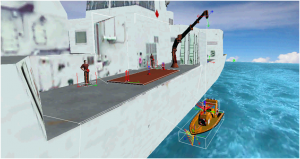Canada is in the process of undertaking the largest acquisition of complex naval technology in the country’s history through the National Shipbuilding Procurement Strategy (NSPS). This, as well as maintaining an effective operational fleet, are key priorities for the Royal Canadian Navy (RCN).
Defence Research and Development Canada (DRDC), working with its partners in the Department of National Defence (DND), Canadian industry and international research organizations over the past many years, has continued to develop the technology and expertise to enable the ship acquisition process while maintaining operational readiness in the existing fleet.
As the national leader in defence and security science and technology and an agency of DND, one of DRDC’s priority areas is to support research that delivers direct impact to the Canadian Armed Forces. As such, DRDC provides a national and international hub of expertise to RCN ship projects in naval platform technologies such as structural resilience, survivability, sea keeping, maneuverability, stability, operational simulation and signatures. These areas are essential in ensuring that RCN ships can undertake a wide spectrum of peace-time and combat operations in the most effective and efficient manner possible.
Advances in computing technology allow efficient simulation and evaluation of ships in various operational scenarios. Computational fluid dynamics and finite element analysis allow for the evaluation of such complex problems as the airflow patterns caused by the ship superstructure on the helicopter flight deck, the response of a ship to underwater explosions, and the complex flow field affecting maneuvering performance of ships and submarines.
At the time of design and construction of the Halifax-class Canadian Patrol Frigates in the 1970s, a computational model of only a small part of the ship would take days or even weeks of computing time on a mainframe computer. Today, models of the entire ship can run in minutes on a laptop and in some cases, these advanced complex simulations can reduce the need for expensive model and full-scale sea trials.
Real-time simulation of complex naval operations such as Replenishment at Sea, Launch and Recovery and others, have become a reality through collaborative efforts with Canada’s NATO allies. These high-fidelity, physically accurate simulation capabilities allow the assessment of new equipment or a change in operations for existing vessels without the expense of purchase and sea trials. For example, a simulation of launch and recovery of new boats on the Halifax-class can help assess crane capabilities and any limitations in operations that these new boats may have before purchase and sea trials. Simulations of operations in extreme seas or extreme events (e.g., capsizing, response to damage, etc.) provide knowledge which would otherwise not be available due to physical limitations.
Not everything can be determined through computer simulation, so DND and DRDC have partnered with the National Research Council (NRC) to undertake scaled model tests in their model basin facility in St. John’s, NL; this is a necessary process before any new ship goes to final design and in order to validate computer simulations as they are developed.
Survivability is an essential part of warship design. Through computational advances and validation of analysis methods with our allies, it is possible to analyse complex structural and equipment response to weapons loads, such as underwater explosions and air blast. Methods of analysing ship signatures and of simulating and evaluating damage control technologies – including those used to combat smoke, fire, and flooding, and to facilitate evacuation – are also being studied and developed.
Dealing with very large quantities of data is necessary to undertake the many complex analyses to develop and verify design. DRDC is working with Canadian industry and international partners to address this challenge and create a common ship database, created from the designer’s files, and from which all variety of evaluation models can be derived. A common ship data base framework, even if only partially successful, will greatly enhance the speed of, and enable the use of, a wider range of complex analysis tools (survivability, signatures, stability) in ship design assessment.
Full-scale trials on the finished product are necessary to the ship evaluation process, even with the advances that complex computer modelling and scale model tests have created. DRDC continues to develop and improve its ability to support the RCN in this regard, most-recently assisting with Halifax-class modernization manoeuvring and helicopter landing full-scale trials.
Effective, efficient through-life-management of the delivered vessels is also being addressed through science and technology. Determining the abilities of a damaged vessel (corrosion, fatigue cracks, war damage) to undertake a given mission is a complex subject falling outside the realm of design rules but with very significant consequences (e.g., potential removal of a vessel from its defence and security service). Simulation of the expected environmental conditions and the damaged ship response to those loads, and the effects of possible repair strategies is the subject of much research in the naval science community.
DRDC looks forward to providing continued support to the Royal Canadian Navy by applying technological advances to support the RCN both today, and in the future. We strive to assist in defining achievable, validated and affordable requirements, advise on design alternatives, evaluate options, measure deliverable performance, and to support operations of the RCN fleet.
Neil Pegg is the Section Head of Warship Performance with Defence Research and Development Canada.

